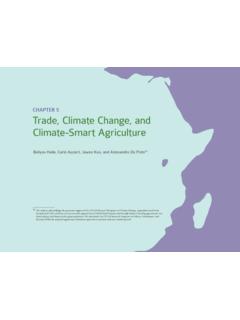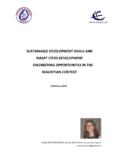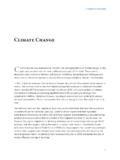Transcription of “Climate-Smart” Agriculture
1 FAO/Ishara Kodikara / FAO climate - smart AgriculturePolicies, Practices and Financing for Food Security, Adaptation and Mitigation climate - smart Agriculture Policies, Practices and Financing for Food Security, Adaptation and Mitigation Food and Agriculture Organization of the United Nations (FAO) 2010 The contents and conclusions of this report are considered appropriate for the time of its preparation. They may be modified in the light of further knowledge gained at subsequent stages.
2 The designations employed and the presentation of material in this information product do not imply the expression of any opinion whatsoever on the part of the Food and Agriculture Organization of the United Nations (FAO) concerning the legal or development status of any country, territory, city or area or of its authorities, or concerning the delimitation of its frontiers or boundaries. The mention of specific companies or products of manufacturers, whether or not these have been patented, does not imply that these have been endorsed or recommended by FAO in preference to others of a similar nature that are not mentioned.
3 All rights reserved. Reproduction and dissemination of material in this information product for educational or other non-commercial purposes are authorized without any prior written permission from the copyright holders provided the source is fully acknowledged. Reproduction of material in this information product for resale or other commercial purposes is prohibited without written permission of the copyright holders. Applications for such permission should be addressed to: Chief Electronic Publishing Policy and Support Branch Communication Division FAO Viale delle Terme di Caracalla, 00153 Rome, Italy or by e-mail to.
4 FAO 2010 Acknowledgments This paper is the outcome of a collaborative effort between the Natural Resources Management and Environment Department, the Economic and Social Development Department, the Agriculture and Consumer Protection Department, the Fisheries and Aquaculture Department and the Forestry Department of the Food and Agriculture Organization of the United Nations (FAO). The authors include Leslie Lipper, Wendy Mann, Alexandre Meybeck, Reuben Sessa with the technical contributions of Moujahed Achouri, Doyle Baker, Caterina Batello, Catherine Bessy, Susan Braatz, Jeronim Capaldo, Francis Chopin, Linda Collette, Julien Custot, Olivier Dubois, Cassandra De Young, Theodor Friedrich, Michelle Gauthier, Pierre Gerber, Vincent Gitz, Kakoli Ghosh, Robert Gouantoueu Guei, Benjamin Henderson, Irene Hoffmann, Peter Holmgren, Amir Kassam, Philippe Le Coent, Clemencia Licona Manzur.
5 Nebambi Lutaladio, Harinder Makkar, Divine Nganje Njie, Thomas Osborn, Joachim Otte, Julio Pinto Cortes and Doris Soto and the kind assistance of Emelyne Cheney, Sara Granados, Maria Guardia and Lisen Runsten. Content Scope of paper .. ii Key messages .. ii Introduction .. iii Part 1 - Examples of climate - smart production systems .. 1 Introduction .. 1 Considerations for climate - smart production systems .. 1 Achievements and constraints .. 3 Existing systems, practices and methods suitable for climate - smart Agriculture .
6 3 Crops: rice production systems .. 4 Crops: Conservation Agriculture .. 5 Livestock production efficiency and resilience .. 7 Agroforestry .. 9 Fisheries and aquaculture .. 11 Urban and peri-urban Agriculture .. 13 Diversified and Integrated Food - Energy Systems .. 15 Part 2 Institutional and policy options .. 17 Enabling policy environment .. 17 National policy-making .. 17 Coordinated international 18 Institutions: information production and dissemination .. 18 climate data and information gaps.
7 19 Dissemination mechanisms .. 19 Institutions to improve access, coordination and collective action .. 20 Institutions to support financing and insurance needs .. 21 Credit .. 21 Insurance .. 21 Social Safety Nets .. 21 Payments for environmental services .. 22 Part 3 Financing and Investments for climate - smart Agriculture .. 24 Why financing is needed .. 24 Financing gaps .. 24 Sources of financing .. 26 Blending different sources of financing .. 26 Leveraging .. 28 Financing mechanisms.
8 28 Weaknesses of existing mechanisms .. 28 New mechanisms .. 29 Architecture that enables action, including by Agriculture .. 29 Connecting action to financing .. 30 National level .. 30 Linking to farmers .. 30 MRV .. 31 Pilots .. 31 References .. 32 Acronyms .. 36 Annex I: Methods and Tools .. 38 iiScope of paper Agriculture in developing countries must undergo a significant transformation in order to meet the related challenges of achieving food security and responding to climate change. Projections based on population growth and food consumption patterns indicate that agricultural production will need to increase by at least 70 percent to meet demands by 2050.
9 Most estimates also indicate that climate change is likely to reduce agricultural productivity, production stability and incomes in some areas that already have high levels of food insecurity. Developing climate - smart agriculture1 is thus crucial to achieving future food security and climate change goals. This paper examines some of the key technical, institutional, policy and financial responses required to achieve this transformation. Building on case studies from the field, the paper outlines a range of practices, approaches and tools aimed at increasing the resilience and productivity of agricultural production systems, while also reducing and removing emissions.
10 The second part of the paper surveys institutional and policy options available to promote the transition to climate - smart Agriculture at the smallholder level. Finally, the paper considers current financing gaps and makes innovative suggestions regarding the combined use of different sources, financing mechanisms and delivery systems. Key messages 1) Agriculture in developing countries must undergo a significant transformation in order to meet the related challenges of food security and climate change. 2) Effective climate - smart practices already exist and could be implemented in developing country agricultural systems.














